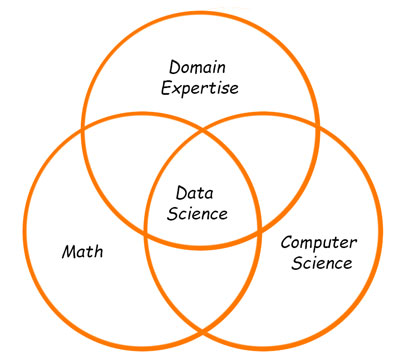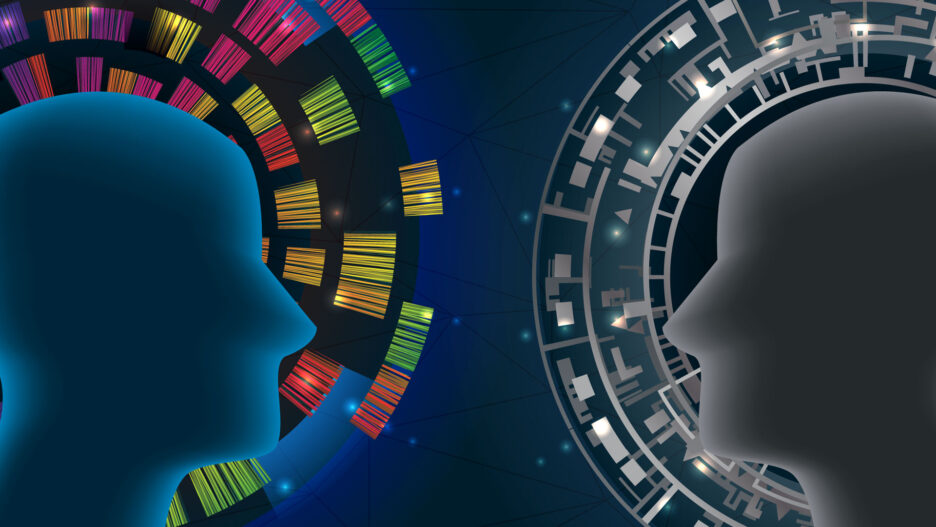What is data science?
How can data science help you to come up with new, high-quality solutions in the modern world?
There is a lot of data, both structured and unstructured, available in any given field today, but it is not meaningful on its own. Data science is the process of expanding our knowledge in broad fields such as fundamental science, industry, medicine, and education, by organizing data so it can be understood and utilized. Although the term data science first appeared in the early 1960s, the first scientific conferences on this topic were held in the late '90s.
Data Science aims to improve product development processes, decision-making processes, trend analysis processes, and forecasting processes through taking advantage of the various fields of data analysis, such as statistics, classification, clustering, machine learning, data mining, and predictive analytics.

According to Rachel Schutt and Cathy O’Neil’s book “Doing Data Science”, a Data Scientist is “someone who knows how to extract meaning from and interpret data, which requires both tools and methods from statistics and machine learning, as well as being human.”
At the heart of data science, there is a deep connection to statistics, although data science should not be reduced to only statistical algorithms and methods of information processing.
The science of data is most useful in areas such as machine translation, speech recognition, robotics, search engines, biological sciences, medical computer technology, and social sciences.
What is data analytics?
The simple answer to the question of what is data analytics would be - a discipline that collects and studies information and allows for decision making on the basis of the analysis of large volumes of data. Data analysis is a more specific area than data science.
Data analysis allows you to discover the hidden relations in data and thus revolutionize decision making in public administration, health care, education, economics, business, and almost all other human activities where there are have large datasets.
The most comprehensive description of data analysis is given as “Data Analysis is the process of systematically applying statistical and/or logical techniques to describe and illustrate, condense and recap, and evaluate data.”
A well-rounded definition of data analytics is taken from Investopedia: “Data analytics is the science of analyzing raw data in order to make conclusions about that information. Many of the techniques and processes of data analytics have been automated into mechanical processes and algorithms that work over raw data for human consumption.”
And one of the valuable parts of data analytics is data mining, as shown.

Process and goals of data analysis
The process of data analysis begins with existing information that is already present in the organization or project.
Data analysis is focused on descriptive analysis of information related to the domain area.
This requires a profound knowledge of the subject area and the ability to interpret the results in the form of figures into specific indicators of the industry in which the data analysis specialist works.
In this case, it is necessary to have the ability to correctly represent and visualize the data so that they are understandable to users in the context of the business environment.
The goals of data analytics are to support decision-making activities by cleaning, investigating, transforming, and training data. On the other hand, Data Analysis is a subcategory science that examines raw data to draw insights and conclusions from datasets with the same purpose of supporting decision-making.
Knowledge of statistics and programming skills are often helpful in the work of the data analyst.
The data analysis process consists essentially of a simple sequence of steps, but each of these steps can be a complicated and time-consuming process:
- Define the questions you need to answer with the data.
- Decide what and how to measure in the input and output data.
- Collect and prepare (normalize) data to dataset.
- Analyze data.
- Give the right explanation to make it understandable and visualize it.
The purpose of data analysis is to carry out one of four types of analysis, defined as:
Descriptive analytics Used to describe what happened over a specific period of time. | Diagnostic analyticsFocused on unearthing why a specific event occurred. |
Predictive analyticsUsed to make predictions about something that is likely to happen. | Prescriptive analyticsFocused on suggesting a data-backed course of action. |
And more specifically, from these four types of analysis, the following main activities are applied.
Classification. In classification, characteristic properties are assigned to groups of objects in the studied data set - classes. According to these properties, a new object can be assigned to this or that class.
Clustering. Clustering is the logical continuation of the idea of classification. This task is more complicated, and the difference with the clustering feature is that object classes are not predefined.
Associations. In the course of solving the problem of searching for associative rules, patterns are found between related events in a data set.
Forecasting. As a result of solving the prediction problem, missing or future values of the target numerical indices are estimated based on historical data.
Deviation Detection. Detecting and analyzing data that is the most different from the whole of the data, identifying so-called non-characteristic patterns.
Estimation. The objective of estimation is to predict the continuous values of the attribute.
Link Analysis is the task of finding dependencies in a data set.
Visualization (Visualization, Graph Mining) As a result of visualization, a graphical image of the analyzed data (data representation in 2-D and 3-D measurements) is created.
Data science and analytics comparison
Data analytics vs Data science Concept
The concept of data science vs data analytics underlies the methods and approaches to processing information within this discipline and in real practical tasks.
First of all, the data science and analytics concept involve a statistical approach, using the corresponding sections of higher mathematics.
The second important contribution to the concept of data science is the probability distribution.
The concept also includes dimensionality reduction, which enables you to work with big challenges and reduce them to a solvable view while still producing a high-quality solution. The next approach is over and undersampling, which works perfectly with classification tasks and allows you to solve tasks with incomplete data sets.
And, particular attention needs to be paid to approaches using Bayesian methods, in particular, Bayesian statistics.
Data analysis can be considered an application section of mathematical statistics, but it should be emphasized that data analysis involves the processing of both quantitative and qualitative data.
The concept of data analytics uses methods of pre-processing data to transform and normalize data from row representation to acceptable forms for analysis. It includes the formulation of data requirements, defining procedures of data collection, building systems of data processing, and finding proper data cleaning procedures.
Data analytics also uses mathematical methods of correlation analysis, dispersion analysis, regression analysis, covariance, discriminant analysis, cluster analysis, and time series analysis.
Application areas
First of all, the science of data allows us to solve problems which were not solvable using classical algorithms.
This covers tasks with poorly defined input information, such as speech recognition and speech synthesis, pattern recognition, processing of unstructured data in economics - wherever it is impossible to write a straightforward solution algorithm due to the complexity of processing the number of possible variants of a task.
One important such area areas are medical image analysis, which helps to detect tumors, artery stenosis, and organ delineation. The value of data science in medical applications cannot be overstated.
It is possible to handle large datasets of information about patients and then to find the relationship between different symptoms and predict the correct treatment strategy for each individual patient.
Data science helps in the field of genetics and genome research to find certain effects of drugs and treatment methods for a large number of patients.
Data science can also contribute to many other fields, improving internet search, targeted advertisement, recommendation systems, planning of transportation routes, translation from different languages, etc.
In the banking area, data science helps with the segmentation of clients, risk analysis, fraud detection, online analytics, forecast, etc.
Data analytics will be effective in the areas of transportation, policy, and security, fraud and risk detection, risk management, logistics, healthcare, energy management, internet search, and digital marketing.
Data science and analytics approaches
Two main approaches in data analytics are described in this article.
The first approach is the exploration of data, and the second approach is hypothesis testing. Both of them can be effective for businesses and science.
The exploration of data approach requires a strong background in the domain area.
The hypothesis testing approach requires knowledge of statistics and mathematical algorithms to confirm or disprove the given hypothesis.
Data science approaches to solving problems may be, for example, top-down or bottom-up.
The top-down approach creates the hypothesis and then searches the data for confirmation, thus moving from a general idea to details and their implementation.
The bottom-up approach uses interesting relations in data or data anomaly, then analyzes the domain-specific meaning and builds a strategy from details to general conclusions.
Making the right choice between data science and big data analytics
Data science is a more general approach to the problem, as mentioned at the beginning of this article.
Data analytics is more task-oriented compared to data science, which is a broader view of modern scientific and practical problems.
To help with making the right choice in data science vs data analytics, please refer to the following tables.
| Data Science | Data Analytics | |
| Type of analysis | Descriptive Analytics + Predictive Analytics | Descriptive Analytics |
| Scope of analysis | Macro | Micro |
| Goals of research | Find the right questions to confirm with available math methods | Find valuable data and its business meaning |
| Fields of application | Machine learning, AI, computer vision, automatic language translation, corporate business analysis | Businesses with on-the-spot data needs, transportation, policy and security, fraud and risk detection, healthcare, energy management, internet search, digital marketing |
The main similarities between Data Science and Big Data Analytics are:
- The use of Big Data. Each field harnesses Big Data in different ways to achieve different results, but in essence, they both rely on the use and understanding of Big Data to discover valuable information.
- Both Data Science and Data Analytics share a statistical background. Data Science leans more towards computer science and software engineering and is mainly focused on using data during software production to build models or create recommendation systems, to name a few examples.
Data Analyst
Role: find data and use it to help businesses to make better decisions.
Tasks: collect data, data handling, analyze data, make reports.
Skills required: domain area expertize more important than knowledge of data processing, business understanding skills.
Education Degree: Bachelor’s degree.
Data Scientist
Role: find methods of data processing to help businesses make predictions and plan new directions, drive innovations.
Tasks: find new relations in existing data and form new data collection to improve the general development strategy for businesses, develop operational models.
Skills required: detailed knowledge of data processing, statistics, math methods, machine learning, programming, some level of domain area expertise
Education Degree: Bachelor or Master of Science degree
To sum up, both disciplines are thoroughly interconnected, oftentimes working in conjunction to deliver the same goals: improved decision-making and growth. Rather than battling it out, they work together to complement each other in a highly interconnected data world where we are barely able to keep up.
Conclusion
We collectively create over 2.5 quintillion bytes of data on a daily basis, which demonstrates the mind-boggling acceleration of data production.
In the dispute of data science vs data analytics, both are an important part of modern technology. Businesses with well-staffed and well-run data science and data analytics departments will have advantages over other companies.
Nowadays, we rely heavily on data to make any type of business decision. Data Science and Data Analytics have taken an integral role by introducing the methods, tools, and techniques that help achieve a superior data-driven decision-making process that is revolutionizing the business landscape.





